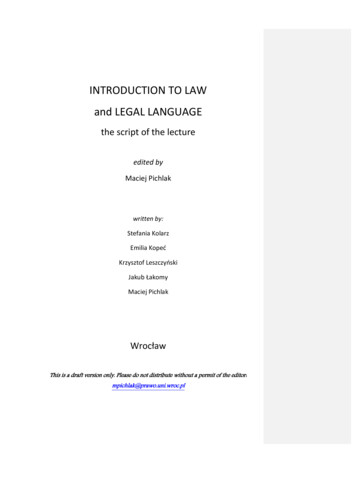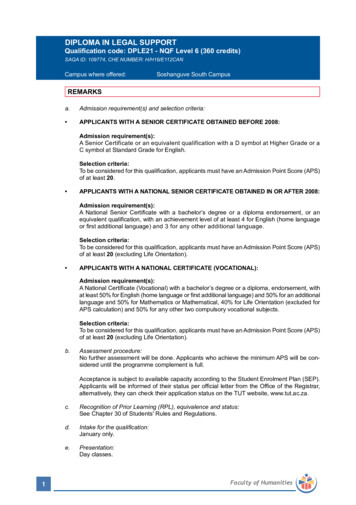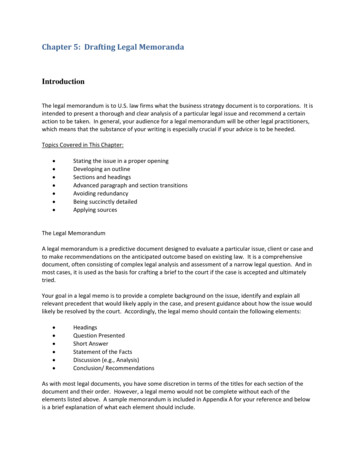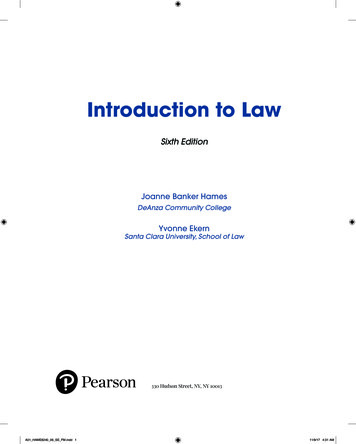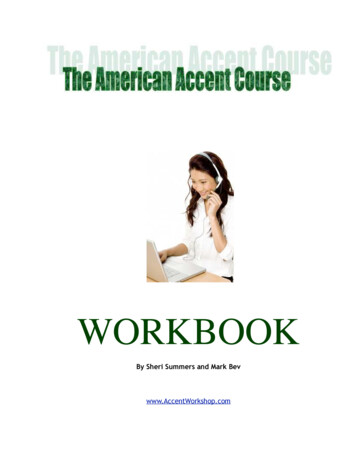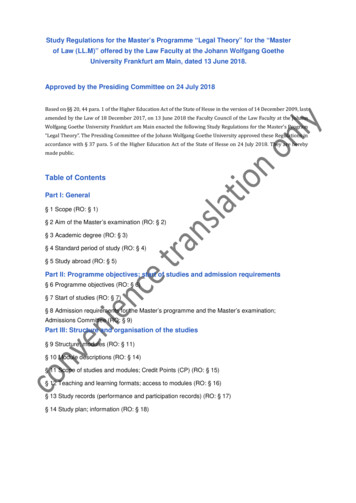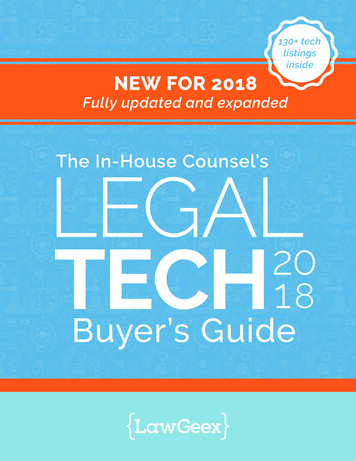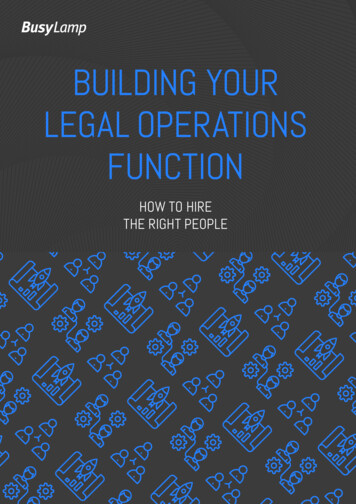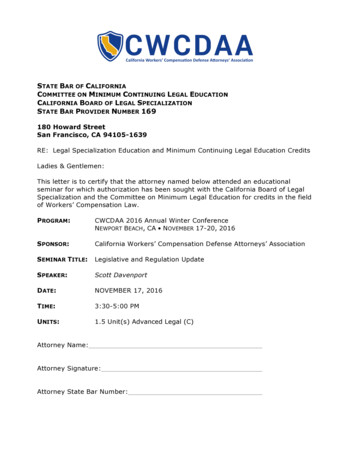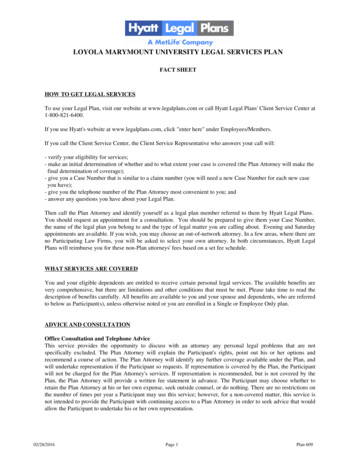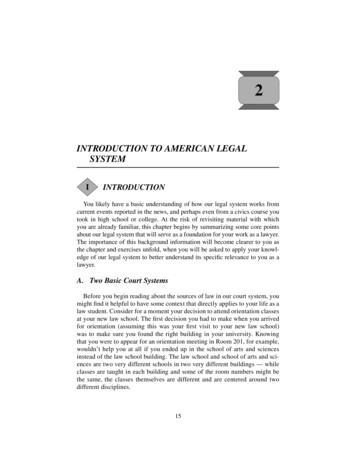
Transcription
2INTRODUCTION TO AMERICAN LEGALSYSTEMIINTRODUCTIONYou likely have a basic understanding of how our legal system works fromcurrent events reported in the news, and perhaps even from a civics course youtook in high school or college. At the risk of revisiting material with whichyou are already familiar, this chapter begins by summarizing some core pointsabout our legal system that will serve as a foundation for your work as a lawyer.The importance of this background information will become clearer to you asthe chapter and exercises unfold, when you will be asked to apply your knowledge of our legal system to better understand its specific relevance to you as alawyer.A. Two Basic Court SystemsBefore you begin reading about the sources of law in our court system, youmight find it helpful to have some context that directly applies to your life as alaw student. Consider for a moment your decision to attend orientation classesat your new law school. The first decision you had to make when you arrivedfor orientation (assuming this was your first visit to your new law school)was to make sure you found the right building in your university. Knowingthat you were to appear for an orientation meeting in Room 201, for example,wouldn’t help you at all if you ended up in the school of arts and sciencesinstead of the law school building. The law school and school of arts and sciences are two very different schools in two very different buildings — whileclasses are taught in each building and some of the room numbers might bethe same, the classes themselves are different and are centered around twodifferent disciplines.15
16Legal Reasoning, Writing, and Other Lawyering SkillsCh. 2Similarly, as a law student and ultimately as a lawyer, you will likewise needto identify “where you are” in terms of the legal issues you will be researchingand evaluating. There are two basic court systems in our country — federal andstate. The federal court system has its own set of laws and courts, and each statealso has its own unique set of laws and courts. Like your law school and theschool of arts and sciences, both federal and state legal systems operate simultaneously and pretty much independently.When a client asks you for legal advice, one of the first things you will needto do is figure out which court system and set of laws controls your client’sactions. Some conduct is governed solely by the state court legal system, whileother conduct is governed solely by the federal court legal system. And there arealso some instances in which both federal and state laws apply. So, for example,if your client lived in Chicago, Illinois and had a legal issue that arose there, youwould first need to consider whether federal laws or Illinois state laws governedthe client’s conduct — or both. Assuming the legal matter happened to involvelitigation, that information would also denote the type of court (Illinois statecourt or federal court) in which you would file a lawsuit on behalf of the client.As a general rule, federal courts and agencies interpret legal issues that arisefrom federal law, while state courts resolve legal disputes that arise from statelaws.1B. Sources of LawThe laws from both the federal and state legal systems stem from three primary sources: the Constitution, statutes, and common law.1.ConstitutionsAlthough constitutional laws are relatively small in number, they areimportant because they protect rights that we as a society have found tobe of fundamental importance. The right to be free from “unreasonablesearches and seizures” is one such important right. As a law student, youwill have the opportunity to study cases interpreting the important rightsthat are embodied in the Constitution in a specific class focused on constitutional law.1As you will learn in your civil procedure class, there are a few exceptions.Even though the federal and state court systems are separate legal systems, federal courts, in limited circumstances, sometimes hear disputes that arise fromstate laws. Similarly, state courts sometimes consider federal laws, assumingcertain jurisdictional issues are satisfied.
Introduction to American Legal System2.17Statutes & Administrative RegulationsIn both the federal and state legal systems, the legislative branch of government also creates law by enacting statutes that govern the rights and duties ofthe people who have the requisite minimum contacts within that jurisdiction.Although legislators enact statutes, they also authorize agencies to issue regulations that help interpret and clarify what a statute means. For example, youmight be familiar with Title VII, a statute that makes it illegal for employers todiscriminate against their employees on the basis of their race, religion, gender,or place of birth. Congress also gave a federal agency the authority to implement regulations and guidelines that help interpret Title VII and give it practicaleffect — the Equal Employment Opportunity Commission (the EEOC).3.Common LawSome laws do not have their source in a constitution or statute. Instead, theselaws evolve solely from court decisions, and are called the “common law.”How did common law evolve? Judges started from a few basic ideas that seemedto be universally accepted in medieval society. As new factual controversiesarose, the judges expanded on and refined their interpretations of the commonlaw by focusing on the similarities to and distinctions from previous cases.Although the common law originated in England, it was brought to the UnitedStates by British colonists, eventually becoming each state’s original body oflaw.2 Today, although statutes have replaced a fair amount of the common law,the common law still exists today. As importantly, the common law method ofreasoning by analogy is still the primary means by which lawyers evaluate casesand predict what the law might say about their clients’ conduct.EXERCISE 2-1:NATURE OF THE LAWSometime in the future, as a result of a major catastrophe, life as we know itno longer exists.3 A group of survivors congregated and formed a new society,Gilligan’s Island. During one of the many social gatherings on the island, theSkipper became enamored with Ginger, an attractive young woman who hadcaptured the interest of a number of men, including the Professor. In fact, Ginger2Richard K. Neumann, Jr., Legal Reasoning and Legal Writing: Structure,Strategy, and Style 5 (4th ed. Aspen L. & Bus. 2001).3The ideas for Exercises 2-1–2-3 were inspired by James E. Moliterno& Fredric I. Lederer, An Introduction to Law, Law Study, and the Lawyer’s Role,Ch. 3 (1991).
18Legal Reasoning, Writing, and Other Lawyering SkillsCh. 2and the Professor had been romantically involved for a period of months and theProfessor was hopelessly in love with her. However, Ginger was a shamelessflirt and encouraged the attention of both the Skipper and the Professor. Duringone particularly heated confrontation over which man was more deserving ofGinger’s affection, the Professor became enraged and struck the Skipper overthe head with a shovel, killing him.The group of survivors quickly elected you as judge and directed you toempanel a group of citizens to try the Professor for killing the Skipper. Duringhis trial, the Professor admitted that he killed the Skipper, but claimed that hehad broken no law because the island does not have a law that forbids killing.As the judge in the Professor’s case you clearly have been delegated the powerto hear the case, i.e., you have jurisdiction. However, before you can proceedwith the Professor’s trial, you must decide if killing someone is against the lawon the island. Deciding whether killing is against the law on the island requiresyou to think about the question of what “law” is.Does law consist only of positive, affirmative declarations? That is, must someone with recognized authority enact a rule in order for there to be a law that canbe enforced? If that definition of law is too narrow, from where else might “law”be derived? From religious doctrine? From societal values? From natural law?In our legal system, the judge typically decides what the “law” is. As judge,what is your decision in the Professor’s case? What value judgments does yourdecision embody?If you believe that you should penalize the Professor for killing the Skipper,what are the limits of this approach? Would you reach the same result if theProfessor had only injured the Skipper rather than killed him? What if the injurywas merely a bruised rib cage from which the Skipper fully recovered? If youwould rule differently under these facts, why?C. How the Branches of Government Work TogetherAlthough each source of law stands on its own, there is also significantinterplay between the three branches of government. Because constitutionsand statutes are generally future-oriented, they are written in broad, generalterms that embrace a wide range of future conduct that might fall within theirambit. Inevitably, when the broad language of a statute or constitution isapplied to a specific factual situation, questions arise. Does this specific conduct fall within the ambit of that law? Is this particular individual the type ofperson the legislature intended to cover? As these questions arise in individualcases, judges are required to interpret the meaning of specific statutes and
Introduction to American Legal System19constitutions. By giving texture and additional substance to the law, judgesplay an active role in the evolving interpretation of what a law means, evenwhen the law itself is based on a statute or constitution.Sometimes when a judge interprets a statute, the legislature disagrees withhow the court interpreted the statute. When that happens, the legislature mightamend the statutory language to clarify its meaning. In the process, the newlegislation invalidates earlier court decisions that interpreted the statute in adifferent manner. For example, in 1991, Congress amended the Civil RightsAct of 1964 so as to nullify a series of Supreme Court cases that interpretedthe Civil Rights Act in a manner with which Congress disagreed.The process sometimes works the other way as well. When the legislaturepasses a statute it must pass constitutional muster — a judge can invalidate astatute if the judge concludes that it violates either the relevant state’s or UnitedStates constitution. For example, in the landmark civil rights case of Brownv. Board of Education, the United States Supreme Court invalidated a Kansasstatute that permitted the segregation of public schools, holding that the statesanctioned segregation violated the 14th Amendment to the Constitution.EXERCISE 2-2:NATURE OF THE LAWConsider again the Gilligan’s Island scenario. Assume that, following yourruling in the Professor’s case, the new society realized that it should enact somelaws that embody the values of the people. The citizens elected a twenty-personlegislative body and authorized that representative group to adopt any lawsthey believe to be fair and just. The legislative body quickly and without debateenacted the following statute:Any person who kills another person shall be guilty of murder andshall be sentenced to death or life in prison.Some months later, Mr. Thurston Howell, III injured his back while helpingto build a new community center. To help relieve the pain, Mr. Howell took apowerful herbal pain reliever before going to sleep. The herbs not only helprelieve Mr. Howell’s pain and allow him to sleep, but make his dreams unusually vivid. During that particular night, Mr. Howell dreamt that he was beingattacked by a lion. While still asleep, Mr. Howell believed that he was subduingthe lion that was attacking him. In reality, Mr. Howell suffocated Mrs. Howellwith a pillow, killing her.
20Legal Reasoning, Writing, and Other Lawyering SkillsCh. 2You are the duly elected judge on the island. The island constable arrestedMr. Howell and brought him before you for trial on murder charges. Mr. Howelladmitted he killed Mrs. Howell, but claimed that the killing was not against thelaw because it was an accident and he certainly did not intend to kill his wife.As the judge, you must decide what the statute means. When interpreting astatute, judges typically begin by reading the statutory language to identify itsplain meaning. When the language is ambiguous or when the plain meaningwould lead to an absurd or unreasonable result, judges sometimes go beyondthe literal language of the statute and look for legislative intent by examining thestatute’s legislative history. Here, however, there is no legislative history, as thelegislative body passed the statute quickly and without debate.What is your decision in Howell’s case? Should you apply the plain meaningof the statute and find Mr. Howell guilty of murder? Or should you go beyondthe plain meaning and conclude that the legislatively body surely would haveexempted killing under these circumstances had they thought of it? What arguments support your decision?Before reading any further, take a moment and consider the potential problems with the decision you just reached — what undesirable consequences couldresult from that decision?D. Our System of Stare DecisisBy now, you have identified a conundrum that judges sometimes face wheninterpreting the law. On the one hand, judges want to impose rulings that are fairand seem to further the legislative intent or policy concerns underlying the law.On the other hand, our legal system is premised on the idea that there be predictability and consistency in how our laws are interpreted. It would be difficult forus, as citizens, to know what behavior is lawful unless we know what the lawmeans and can trust that it will be interpreted consistently in the future. Therefore,judges look to the decisions of prior courts for guidance in interpreting the law.This process of judicial interpretation is known as stare decisis — a Latin phrasethat means that courts should stand by earlier legal decisions (“precedent”) andinterpret the law in the same way as earlier courts have done.EXERCISE 2-3:NATURE OF THE LAWConsider again the Gilligan’s Island scenario. Whatever your actualdecision in Exercise 2-2, assume for present purposes that the judge inHowell’s case decided to apply probable legislative intent rather than the
Introduction to American Legal System21plain meaning of the statute. Therefore, the judge instructed the jury, in theform of a written decision, that “the crime of murder requires the intent tokill.” After deliberating, the jury acquitted Mr. Howell, finding that he didnot possess the intent to kill Mrs. Howell. Some members of the legislativebody vocally criticized the judge for “creating” law in this manner, arguingthat only the legislative body should have the ability to create law. Despitesuch criticism, the legislative body did not change the statute. Now assumethat the judge retired, and the legislative body selected you as the newjudge.Six months later, another killing occurred. After drinking seven margaritasand becoming sloppy drunk, Marianne got into a heated argument with Ginger.Although the two women were friends, they had a contentious history betweenthem and were known to quarrel. In the heat of the argument, Marianne becameso enraged that she pulled out a small, snub-nosed pistol and began wavingit around. During her drunken rambling, Marianne pulled the trigger and shotGinger in the chest, killing her. Marianne was so intoxicated that she couldnot walk and had to be carried away to the local jailhouse. The next morningwhen Marianne awoke, she experienced a blackout from the previous evening.Marianne didn’t recall anything about her argument with Ginger, nor did sherecall shooting Ginger or killing her. Marianne has expressed horror that shecould have done such a thing, and claims that she would never knowinglyhave shot her dear friend.The constable arrested Marianne and, because you are the new judge, theconstable brought her before you for trial on murder charges. Marianne claimsthat the killing was not against the law. Marianne argues that she was so intoxicated that she didn’t know what she was doing and could not therefore havepossessed the “intent” to kill Ginger.As the new judge, you must first decide whether to recognize the former judge’sdecision that the “crime of murder requires the intent to kill.” Assume that theAnglo-American system of stare decisis applies. As the new judge, would you,or should you, follow the retired judge’s interpretation of the statute?Assume you decide that your decision should be consistent with Howelland that you therefore adopt the same interpretation of the law as the judgein the Howell case — that the crime of murder requires the intent to kill. Youare now faced with an additional question as you apply the legal definition ofmurder to the facts of Marianne’s case. Are the facts in Marianne’s case closeenough to the facts of Howell as to require the same result (to acquit Marianneof the charge of murder)? Or are the facts different enough to reach a differentdecision than the judge in Howell’s case? What is your decision in Marianne’scase?
22Legal Reasoning, Writing, and Other Lawyering SkillsIICh. 2STARE DECISIS — MANDATORY& PERSUASIVE PRECEDENTIn evaluating cases under our system of stare decisis, judges consider two different kinds of precedent: mandatory and persuasive precedent. As you mightguess from what the names imply, courts are required to follow only earliercases that qualify as mandatory precedent. In contrast, courts may or may not bepersuaded to follow earlier cases that are only persuasive precedent. As a futurelawyer who will advise clients of their legal rights, it is critical that you knowhow to tell the difference between mandatory and persuasive precedent.Whether a case is mandatory or persuasive precedent depends on two questions — the jurisdiction within which the case arose and the hierarchal levelof that court within the jurisdiction. If you remember the following two-parttest, you can resolve any jurisdictional question. A previous case is binding ona new court only if: (1) the previous case arose within the same jurisdiction asthe dispute presently before the court; and (2) the earlier case was decided by ahigher-level court within the same jurisdiction.A. The Jurisdictional Part of the TestThe jurisdictional part of the test can be deceptively challenging if you areunfamiliar with the way in which the federal and state court systems are organized. You can’t begin to answer the question of whether a legal precedent ismandatory or persuasive precedent unless you have a very clear understandingof (a) the jurisdiction in which your new legal problem is based, and (b) thejurisdiction in which the earlier case arose. This is a fundamentally importantquestion that merits some review, even if you are already somewhat familiarwith the federal and state court jurisdictions.1.Federal CourtsFederal courts have jurisdiction to resolve disputes that involve the UnitedStates Constitution, federal statutes, and federal regulations. In addition, federal courts have jurisdiction to resolve disputes that involve state laws if theparties satisfy other jurisdictional requirements (i.e., diversity of citizenship;pendent jurisdiction). Unlike the differing state laws, federal laws are, by definition, national in scope and apply irrespective of whether conduct covered bythe law arises within the State of New York, the State of Florida, or the State ofIllinois.Because our nation is so vast and the volume of lawsuits so expansive,for practical reasons Congress has divided the country into thirteen federal
Introduction to American Legal System23judicial circuits. There are eleven numbered circuits, such as the United StatesCourt of Appeals for the First Circuit, the Second Circuit, and so on. In addition to the eleven numbered circuits, there is also the United States Court ofAppeals for the District of Columbia and the United States Court of Appealsfor the Federal Circuit. The Federal Circuit resolves disputes involving patents, certain international trade disputes, and some cases involving damageclaims against the United States government. Take a look at the accompanying map of the thirteen judicial circuits to gain a sense of how the country isdivided into separate regions. Note that each numbered federal judicial circuit encompasses a number of different states. As you review the map, recall,however, that the jurisdiction of a federal judicial circuit extends only to actswithin those states that affect a federal law. In what federal circuit do youreside?How do the different federal judicial circuits affect the doctrine of staredecisis? An earlier case is mandatory, or binding, precedent only withrespect to new federal court cases that arise within the same judicial circuit.For example, a decision issued by the United States Court of Appeals for theFirst Circuit is binding only on future cases that arise within the First Circuit.That decision does not carry any binding weight within any other circuit.A judge or panel of judges within the Second Circuit is free to agree or disagree with the manner in which the First Circuit Court of Appeals interpretsa federal law.2.State CourtsEach individual state has its own laws and court system. State court judgeshave sole jurisdiction to resolve controversies involving their state’s constitution, statutes, and common law. Therefore, earlier cases have binding effect onlyon future disputes that arise within that same state. In fact, a case from one statehas very little persuasive impact on a judge in another state. As an example, ajudge in the State of Illinois interpreting Illinois’ burglary statute would not berequired to follow a Wisconsin judge’s interpretation of a similar Wisconsinstatute and would likely not even find the Wisconsin case persuasive. Unlike thesources of federal law, which apply nationwide, each state’s laws are differentfrom the laws in other states and result from a unique balancing of interests andpublic policy within that state.B. The Court Hierarchy Part of the TestIn order for an earlier case to have mandatory precedential effect, the earliercase must not only arise from within the same jurisdiction as the problem youare researching, but the earlier case must be decided by a higher-level courtwithin that jurisdiction. The federal government, the District of Columbia,
24Legal Reasoning, Writing, and Other Lawyering SkillsCh. 2
Introduction to American Legal System25and each individual state have their own hierarchy of courts within their courtsystems. However, irrespective of the jurisdiction in which you practice law,an overriding principle applies: higher-level courts are binding on lower-levelcourts. Lower-level courts are never binding on higher-level courts.1.Federal Court SystemThe federal court system has three levels of courts: (1) the trial court level(District Courts); (2) the intermediate appellate court level (United StatesCourts of Appeals); and (3) and the highest appellate court level (the UnitedStates Supreme Court). As the highest level court in the federal system, decisions of the United States Supreme Court are binding on all other federalcourts. Decisions of each United States Court of Appeals are binding only onthe lower federal courts within their jurisdiction. Federal district court decisions are not binding on other courts — even other court decisions within thesame jurisdiction.Graphically, the federal court system is organized like this 4:U.S. Supreme Court(Highest Level Court)U.S. Courts of Appeals (1st – 11th Circuits,and the D.C. Circuit)(Intermediate Courts of Appeals)U.S. District Courts(Trial Level Courts)4In addition, there are also federal courts that have special subject matterjurisdiction, such as federal claims courts, bankruptcy and tax courts, and veterans, armed forces, and international trade courts.
26Legal Reasoning, Writing, and Other Lawyering SkillsCh. 2(a) Federal District CourtsIf you were to file a lawsuit that involved a federal law, you would file thelawsuit in a federal district court, which is the name of the trial level courtwithin the federal judiciary system.5 Each of the twelve federal circuits (theeleven numbered circuits and the District of Columbia), has a number ofdistrict courts within its jurisdiction. The size and number of federal districtcourts within a particular circuit depends upon the size and caseload of thatdistrict. Additionally, each federal district court is typically comprised ofmore than one judge, again depending upon the size and caseload of thedistrict.(b) United States Courts of AppealIf you were to try a case in federal district court and end up in the position ofhaving to appeal the decision of that court, you would appeal to the next highestlevel court in the federal system — one of the United States courts of appeals.If your case were tried in a New York district court, you would appeal the decision to the Second Circuit Court of Appeals, the circuit that encompasses NewYork. On the other hand, if your case were tried in a Texas district court, youwould appeal to the Fifth Circuit Court of Appeals, the circuit that encompassesTexas.All active judges on a federal court of appeals do not hear every case thatcomes before that court. Instead, cases are heard by three-judge panels during one week of the month. Sometimes, for unusually significant cases, allactive judges on a federal court of appeals hear a case together, as a group.These decisions are called en banc decisions — a French term that simplysignifies that the entire panel of judges heard the arguments and rendered anopinion.(c) United States Supreme CourtAssuming that you were in the position of appealing a decision from one ofthe United States courts of appeals, your appeal would be filed with the UnitedStates Supreme Court. As the highest level of court in the land, the nine-memberSupreme Court consents to review only a select few appeals each year. Out of5For present purposes, assume that the legal matter you are handling doesnot involve a specialized issue that would be addressed by the United States TaxCourt, the Court of Federal Claims, or the Court of International Trade.
Introduction to American Legal System27thousands of petitions for appeal every year, the Supreme Court consents tohear only 100 to 200 per year. Generally, it agrees to hear only those casesthat are of exceptional constitutional or statutory magnitude, or those casesupon which lower courts have disagreed in their interpretation of federal law,i.e., where two or more federal circuit courts of appeal are split in their interpretation of an important law. When the Supreme Court declines to hear an appeal,the technical term is that it has denied certiorari. This term is abbreviated forcitation purposes. Thus, when you see the phrase “cert. denied” following thecitation of a case, that means that the lawyers in that case appealed the case tothe United States Supreme Court and that the Supreme Court declined to hearthe appeal.2.State Court SystemsLike the federal court system, many, but not all, states have three levels ofcourts — trial level courts, intermediate appellate level courts, and a final appellate level court. (Most states have courts of limited jurisdiction as well, such assmall claims courts or municipal courts.) However, some states have only twolevels of courts. To complicate matters even further, some states call their finalappeals court the “Supreme Court,” while other states call their final appealscourt the “Appellate Court.” Thankfully, you are likely to practice law only ina few different jurisdictions and will become familiar with your jurisdictions’court systems during summer clerkships or externships, or as you begin practicing law. As law students, however, the Bluebook and the ALWD Manual can behelpful in unraveling a particular state’s court system. Appendix 1 of the ALWDCitation Manual, and Table 1 of the Bluebook, list each state alphabeticallyand designate each state’s court structure.6 Ignoring the courts of very limitedjurisdiction, such as small claims and municipal courts, a typical state courtsystem such as Missouri would look like this:6The ALWD Citation Manual and the Bluebook only list those state courtsfrom which decisions are actually published. In most states, intermediate appellate court and final appellate court decisions are published and are therefore denoted in the ALWD Citation Manual and the Bluebook. However, moststates do not publish their trial court opinions. For example, the State of Missouri does not publish trial court opinions. Thus, the citation manuals do notlist Missouri’s trial level courts.
28Legal Reasoning, Writing, and Other Lawyering SkillsCh. 2Missouri Supreme Court(Final Court of Appeals)Missouri Courts of Appeals — Eastern,Southern and Western Districts(Intermediate Courts of Appeal)Missouri Circuit Courts(Trial Courts)Like the federal court system, in a state system, the highest level of appellatecourt binds all lower level courts. Intermediate level appellate courts bind alltrial level courts within all districts within the state. For example, an earlier casedecided by the Court of Appeals for the Western District of Missouri would bindall state trial courts within the state, even those trial courts that sit within theEastern District of Missouri.However, there is a caveat of which you should be aware: because court decisions are not binding on other courts that operate at the same level, it is possible for different intermediate appellate courts within a state to conflict. Forexample, suppose the Court of Appeals for the Western District of Missouridisagreed with a decision of the Court of Appeals for the Eastern District ofMissouri. As a lawyer trying to sift through the conflicting opinions, you wouldnee
court or federal court) in which you would fi le a lawsuit on behalf of the client. As a general rule, federal courts and agencies interpret legal issues that arise from federal law, while state courts resolve legal disputes that arise from state laws.1 B. Sources of Law The laws from both the federal and state legal systems stem from three pri-
